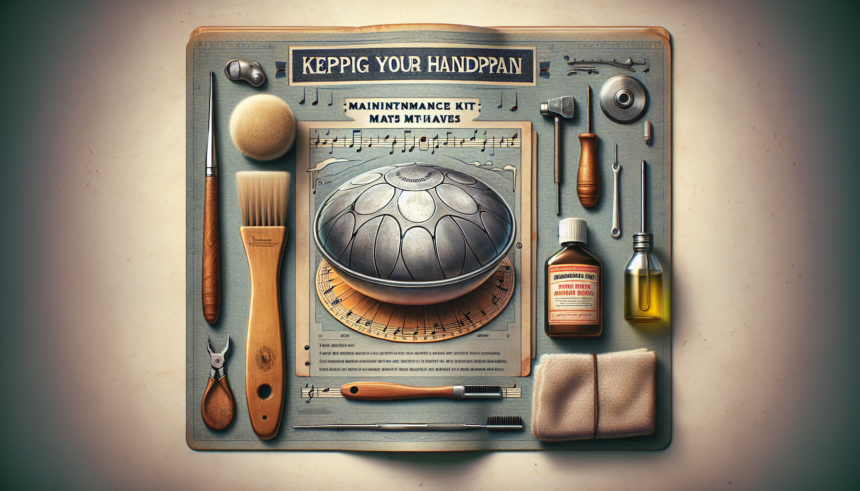The handpan is a unique and captivating instrument that demands a good deal of respect and care to ensure its longevity and optimal performance. Known for its ethereal sound, the handpan can quickly become a musician’s prized possession. Therefore, the importance of maintaining this instrument goes beyond mere aesthetics; it’s about preserving its quality and functional integrity. A comprehensive maintenance kit is indispensable for this task. Here, we’ll explore the essentials that should be part of every handpan maintenance kit.
Why Maintenance is Crucial
The handpan, though sturdy, is susceptible to various environmental and usage factors. Rust, dirt, and physical damage can significantly affect the sound quality and overall integrity of the instrument. Consistent maintenance prevents such issues, ensuring that your handpan remains in perfect condition for years to come.
1. Cleaning Cloth
A high-quality, lint-free cleaning cloth is perhaps the simplest yet most essential tool in your maintenance arsenal. Regularly wiping down your handpan can remove dust, fingerprints, and other surface contaminants that may contribute to wear and tear.
- Use a microfiber cloth specifically designed for delicate surfaces.
- Gently wipe the instrument after each session to keep it clean.
- Consider using a slightly damp cloth for more stubborn dirt, followed by a dry one to remove any moisture.
2. Oil
The handpan is typically made of nitrided steel, a material known for its resistance to rust. However, over time, moisture from the air and from handling can cause corrosion. Regular oiling forms a protective barrier that helps prevent rust.
- Use oils recommended for handpans, such as Phoenix oil or coconut oil.
- Apply a thin layer of oil using a soft cloth every few weeks, depending on usage and environmental conditions.
- Ensure the handpan is completely dry before applying oil to avoid trapping moisture.
3. Desiccant Packs
Desiccant packs are an easy way to combat moisture, especially if you live in a humid environment. These packs absorb excess humidity, thereby providing an additional layer of protection against rust.
- Place desiccant packs inside your handpan’s protective case or storage bag.
- Regularly replace the desiccant packs as they become saturated with moisture.
- Consider using a hygrometer to monitor humidity levels and ensure they remain within the safe range for your handpan.
4. Protective Case
A hard-shell or padded protective case provides indispensable protection against physical damage. Transporting your handpan without proper protection can lead to dents, scratches, and other forms of damage.
- Invest in a high-quality, sturdy case designed specifically for handpans.
- The case should be well-padded and fit the handpan snugly to prevent movement during transport.
- For additional security, look for cases with lockable zippers or latches.
5. Humidifier
While desiccant packs are excellent for reducing moisture, a portable humidifier can be beneficial in drier climates. Extreme dryness can cause the nitrided steel to crack or warp, affecting both the structural integrity and sound quality of your handpan.
- Use a humidifier to maintain a consistent level of humidity in the room where you store your handpan.
- Regularly monitor the humidity levels to ensure they stay within the optimal range.
- Portable, battery-operated humidifiers can be particularly useful for musicians who travel frequently.
6. Tuning Tools
While tuning a handpan is a task usually reserved for professionals, having a basic tuning tool can be helpful for minor adjustments. Proper tuning ensures that your handpan continues to produce its characteristic, harmonious sound.
- Consider investing in a tuning hammer and electronic tuner.
- Familiarize yourself with the basics of handpan tuning, but leave significant adjustments to a professional tuner.
- Regular checks can help you identify tuning issues before they become major problems.
7. Storage Solution
How and where you store your handpan also contributes significantly to its health. Improper storage can lead to accidental damage or environmental wear.
- Store your handpan in a dry, temperature-controlled environment.
- Keep it in its protective case when not in use to shield it from dust and accidental bumps.
- Avoid storing your handpan near heat sources or in direct sunlight.
Conclusion
Maintaining your handpan in top shape requires a proactive approach to its care. By assembling a comprehensive maintenance kit that includes cleaning cloths, oil, desiccant packs, a protective case, a humidifier, tuning tools, and proper storage solutions, you ensure the longevity and optimal performance of your beloved instrument. Regular maintenance becomes much easier and more effective with the right tools, giving you the peace of mind to focus on what truly matters – making beautiful music.
FAQs
1. How often should I oil my handpan?
The frequency of oiling depends on how often you use the handpan and the environmental conditions. Typically, you should oil your handpan every 2-4 weeks. If you live in a humid area or play frequently, oiling more often may be necessary.
2. Can I use any type of oil on my handpan?
No, it’s essential to use oils specifically recommended for handpans, such as Phoenix oil or natural oils like coconut oil. Other oils might contain additives that could harm the instrument.
3. What is the optimal humidity level for storing my handpan?
The ideal humidity level for storing a handpan is around 45-55%. Investing in a hygrometer can help you monitor humidity levels to ensure your instrument remains in optimal condition.
4. How can I tell if my handpan needs tuning?
If you notice that your handpan sounds off-key or the notes don’t resonate as they should, it might need tuning. Regularly playing tuned reference notes and comparing them to your handpan can help you identify tuning issues.
5. Is it safe to clean my handpan with water?
While you can use a slightly damp cloth to clean your handpan, it’s crucial to dry it thoroughly afterward to prevent rust. Avoid using excessive water or harsh cleaning agents, as these can damage the nitrided steel surface.





